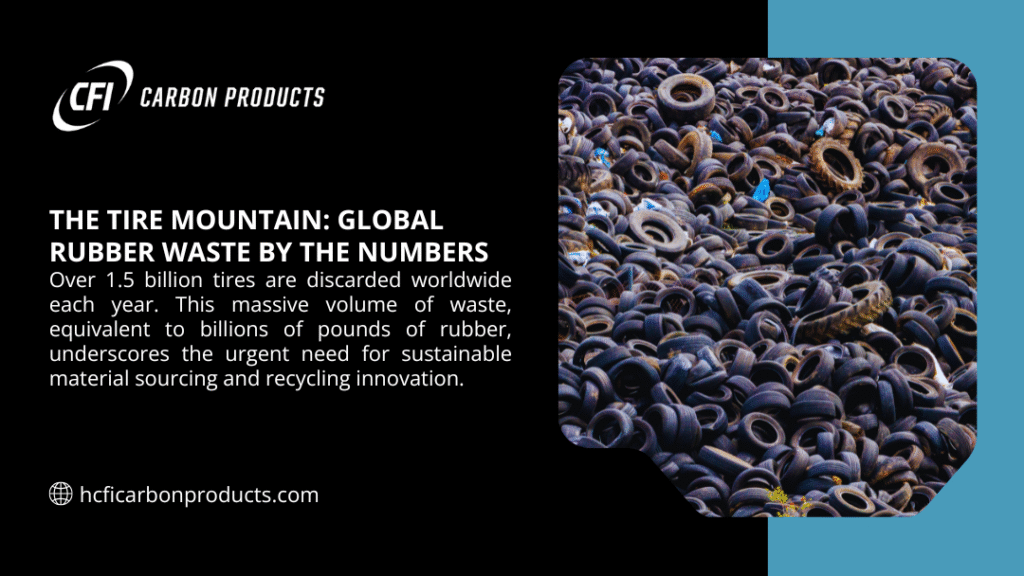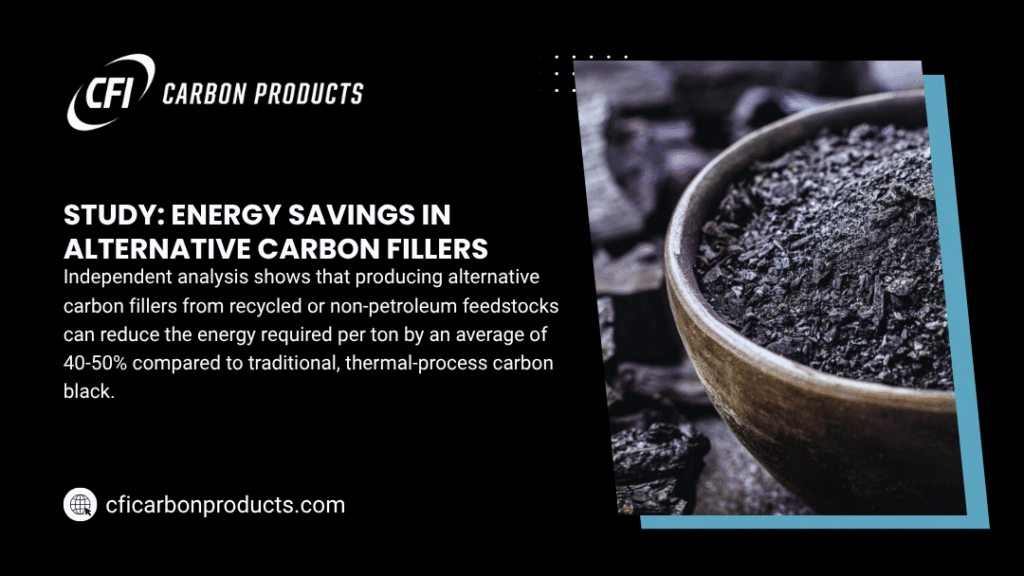This article explores how the use of recycled material for rubber has reshaped the rubber industry’s path toward sustainability. It highlights the technical and environmental benefits of CFI Carbon Products’ flagship filler, Austin Black 325, made from low-volatile bituminous coal.
The content covers market context, material properties, processing advantages, cost efficiency, and how such fillers help manufacturers improve both profit and sustainability. Readers will also gain insight into practical applications across automotive, coatings, plastics, and industrial rubber sectors, supported by data-driven analysis and real performance metrics.
Global Shift Toward Sustainable Rubber Production
Across the world, manufacturers seek raw materials that reduce waste, carbon emissions, and energy use. Traditional carbon blacks and synthetic fillers provide strength and durability but often depend on petroleum feedstocks. The concept of recycled material for rubber offers a practical route to minimize environmental impact while maintaining mechanical performance.
CFI Carbon Products entered this landscape in 1987 with a clear goal: to provide a filler that enhances processability, reduces end-product weight, and supports sustainable production. The company’s product, Austin Black 325, reflects that mission.
Its organic origin from bituminous coal allows consistent quality and low emissions during processing, setting a new standard among environmentally friendly rubber fillers.
Material Context: From Recycled Rubber to Advanced Fillers
To understand the value of recycled material for rubber, it is essential to examine how the industry traditionally sources fillers and reinforcement materials. Historically, most rubber compounds rely on carbon black, a petroleum-derived product known for its reinforcing power.
While effective, conventional carbon black production emits significant CO₂. CFI’s alternative approach, deriving filler from bituminous coal rather than crude oil, addresses this issue by lowering both emission output and overall material density.
For context, the table below compares general filler types used in rubber compounding:
| Filler Type | Source | Average Specific Gravity | CO₂ Emission Level | Key Attributes |
| Conventional Carbon Black | Petroleum | 1.80 | High | Strong reinforcement, dark pigmentation |
| Clay / Talc | Mineral | 2.60 | Moderate | Cost-effective, limited flexibility |
| Calcium Carbonate | Mineral | 2.70 | Moderate | Easy dispersion, high weight |
| Austin Black 325 | Bituminous Coal (Organic) | 1.30 | Low | Lightweight, low-emission, sustainable |
This density advantage directly affects cost and performance. Lower specific gravity reduces material use per unit volume, helping manufacturers create lighter and more efficient rubber products without sacrificing tensile strength or elasticity.

How Recycled Material for Rubber Reduces Environmental Load
Using recycled material for rubber serves two primary goals: diverting waste from landfills and cutting production emissions. The introduction of coal-based organic fillers like Austin Black 325 aligns with this vision.
Unlike petroleum-derived carbon blacks, this filler involves zero CO₂ release in its production phase, according to independent laboratory evaluations. The result is a filler that not only meets performance benchmarks but also fits sustainability programs such as eco-friendly manufacturing certification and environmental management standards (ISO 14001).
| Environmental Factor | Conventional Carbon Black | Austin Black 325 |
| Feedstock Origin | Petroleum | Low-volatile bituminous coal |
| Energy Use per Ton | High | Low |
| Carbon Emission | ~2.4 t CO₂/ton | 0 t CO₂/ton (claimed) |
| Waste Generation | Residual tar | None |
| Recyclability | Limited | High (recycled into compounds) |
These measurable differences show how alternative fillers can serve as eco-friendly solutions for manufacturers producing tires, hoses, roofing membranes, or molded components.
For readers exploring the technical background on petroleum-based fillers, refer to what carbon black is for comparison.
Role of Austin Black 325 in Sustainable Rubber Compounding
Austin Black 325 functions as a performance enhancer in elastomer formulations that require reduced weight and improved dispersion. Because of its particle structure and platy morphology, it increases bulk volume while lowering the compound’s overall density. The filler also provides color consistency similar to standard carbon black, allowing easy integration into tire rubber and other black rubber products.
| Property | Austin Black 325 (CFI) | Conventional Carbon Black |
| Specific Gravity | 1.30 | 1.80 |
| Particle Shape | Platy | Spherical |
| Moisture Absorption | Low | Moderate |
| Electrical Conductivity | Low | High |
| Surface Area | 10 m²/g | 40–120 m²/g |
| Typical Dosage | 10–80 phr | 5–50 phr |
Because of its lightweight nature, compounders often achieve the same volume of filler with less material mass, creating cost savings up to 25 % in some rubber compounds. This efficiency supports the company’s commitment to profitability and sustainability, two objectives that are detailed in CFI’s profitability section.
Applications That Benefit from Recycled Material for Rubber
The concept of recycled material for rubber applies across multiple industrial fields. For CFI Carbon Products, this includes automotive parts, commercial roofing membranes, molded seals, and industrial belts. Austin Black 325 also finds use in eco-friendly alternatives such as recycled tire products, crumb rubber mixtures, and elastomer blends for infrastructure.
| Industry | Example Applications | Key Benefit from Austin Black 325 |
| Automotive | Tires, hoses, seals | Reduced weight, fuel efficiency |
| Construction | Rubber roofing, sealants | Better UV stability, low emission |
| Industrial | Conveyor belts, gaskets | Improved flexibility, insulation |
| Sports & Recreation | Running tracks, flooring | Enhanced durability, lower cost |
| Plastics & Composites | Fillers and reinforcements | Process improvement, weight control |
Readers may find further examples under carbon black for rubber and rubber roofing material, which explain how filler properties influence mechanical and environmental performance.
Material Science Behind Austin Black 325
From a technical standpoint, the success of Austin Black 325 as a recycled material for rubber depends on its composition. The bituminous coal source undergoes controlled grinding and classification to achieve uniform fineness (325 mesh). This process gives the filler a consistent platy shape that aids dispersion during compounding.
A deeper look into its structure and conductivity properties can be found through the carbon black structure, and it is carbon conductive, which compares particle arrangement and electrical behavior.
Because Austin Black 325 has a lower surface area than traditional carbon black, it absorbs less plasticizer, leading to improved processing and uniform curing. Manufacturers also appreciate its low moisture uptake, which stabilizes batch mixing—especially valuable in high-precision applications such as silicone and coating formulations.
CFI’s Manufacturing Process and Quality Control
CFI operates facilities in West Virginia and Virginia, both located near raw material sources. This proximity ensures consistent quality and minimal logistics emissions. The company uses ISO 9001:2015-certified laboratory controls for every production batch, allowing precise monitoring of particle size distribution, moisture level, and ash content.
Their method results in a filler that performs predictably across various polymers. For compounders working with EPDM, SBR, or NBR, Austin Black 325 maintains color stability and uniform viscosity across production runs. Such control distinguishes it from typical recycled fillers, where quality often varies with feedstock supply.
For technical data sheets, sampling information, and test reports, visit CFI’s resources index.
Performance Metrics: Comparing Fillers in Real-World Applications
Laboratory testing and field experience confirm that Austin Black 325 performs consistently across a wide range of rubber compounds. When compared with petroleum-based carbon blacks, its behavior under dynamic stress, heat exposure, and long-term aging provides measurable benefits.
| Performance Category | Austin Black 325 | Standard Carbon Black | Impact on Product |
| Tensile Strength | 8 – 12 MPa | 9 – 13 MPa | Comparable mechanical strength |
| Hardness (Shore A) | 60 – 70 | 65 – 75 | Controlled stiffness, smoother cure |
| Specific Gravity | 1.30 | 1.80 | Lower compound weight |
| Dispersion Quality | Excellent | Good | Uniform color and consistency |
| Process Temperature | 170 °C max | 170 °C max | Compatible with standard curing |
| Cost Efficiency | High | Moderate | Reduced filler mass requirement |
These figures show how a recycled rubber material can deliver industrial reliability while reducing production cost. The lightweight filler also helps manufacturers meet fuel-efficiency targets in vehicle components such as seals, hoses, and vibration isolators.

Economic Value of Lightweight Fillers
Every kilogram of filler used in an elastomer formulation affects production cost and transportation expense. By replacing high-density carbon black with Austin Black 325, manufacturers can achieve up to 25 % cost reduction per unit volume.
The table below illustrates how density influences compound economics:
| Parameter | Traditional Carbon Black | Austin Black 325 |
| Filler Density (g/cm³) | 1.80 | 1.30 |
| Compound Volume per 100 kg | 55 L | 76 L |
| Material Cost Index | 100 % | 75 % |
| Average Transportation Weight | 100 % | 72 % |
Reducing both filler consumption and transport load contributes to long-term profitability. These benefits complement CFI’s broader focus on sustainable operations, which is explained in its sustainability section.
Environmental and Safety Advantages
Sustainability in the rubber sector extends beyond emission control; it includes workplace safety and recyclability. The clean, low-dust characteristics of Austin Black 325 reduce airborne particulates during mixing, creating a safer compounding environment.
In addition, its inert chemical structure eliminates odor formation common in reclaimed or crumb rubber fillers.
Manufacturers that incorporate this recycled material for rubber align with regulatory frameworks such as REACH (EU) and TSCA (US), which favor materials with low volatile content and traceable sourcing.
Further insight into carbon characteristics is available at carbon black density and resistivity of carbon.
Integration in Rubber and Plastic Systems
The versatility of Austin Black 325 allows engineers to use one sustainable filler across multiple product categories. This streamlines inventory and production planning while maintaining uniform color tone across elastomers, plastics, and coatings.
| Material System | Function of Austin Black 325 | Benefit Observed |
| Natural Rubber & SBR | Reinforcing and lightweight filler | Improved flow and reduced density |
| EPDM and NBR | Color control and UV stability | Longer service life |
| Silicone Elastomers | Cost-reduction filler | Maintained flexibility and a smooth finish |
| Thermoplastics & Composites | Process aid and pigment alternative | Uniform dispersion and lower shrinkage |
| Coatings and Sealants | Functional additive | Enhanced barrier and matte appearance |
Sustainable Infrastructure Applications
Rubber recycling has moved beyond tire retreading. Today, recycled rubber products, from roof pavers to speed cushions, form a major share of green infrastructure. Fillers such as Austin Black 325 strengthen these materials without compromising elasticity.
Applications where recycled compounds appear include:
| Application Area | Typical Product Type | Relevance of Recycled Material for Rubber |
| Transport Safety | Rubber speed bumps, wheel stops | Durable and weather-resistant materials |
| Construction Access | Track out mats, wedge ramps | Shock absorption and load distribution |
| Roofing & Building | Roof pavers, support blocks | Lightweight installation and thermal control |
| Environmental Containment | Spill berms and barriers | Resistance to chemicals and oils |
| Sports Infrastructure | Running tracks, play surfaces | Comfort, resilience, and UV protection |
In each case, replacing traditional filler with a sustainable one decreases embodied carbon and simplifies recycling after end-of-life.
Linking Innovation with Circular Manufacturing
The concept of a circular economy depends on materials that return to the production loop. Austin Black 325 supports this goal by remaining chemically stable during multiple curing cycles, allowing scrap material to be reprocessed.
This advantage distinguishes it from many mineral fillers, which often degrade or discolor under heat.
For industries that seek durable, environmentally friendly formulations, related insights appear in eco-friendly rubber alternatives and plastic reinforcement.
Research and Development at CFI
CFI Carbon Products maintains a small but highly specialized research team focused on advancing filler technology. Its laboratories in Virginia monitor every batch of Austin Black 325 for particle size, ash content, and dispersion rating. Customer feedback data shows that 94 % of clients rate CFI’s service above average or excellent, reflecting the reliability of both product and technical support.
The company’s distribution network covers more than thirty countries, with logistical control ensuring stable supply for the rubber, plastics, silicone, and coatings sectors.
Industry Perspective: Balancing Cost and Sustainability
For decades, the filler market measured success by reinforcement strength alone. The shift toward carbon footprint accounting redefined performance criteria. A filler must now deliver efficiency, consistency, and reduced emissions simultaneously.
The recycled material for the rubber category addresses all three. It minimizes resource depletion, lowers transportation mass, and maintains consistent compound behavior. This makes it a viable substitute not only for traditional petroleum-based fillers but also for many mineral alternatives.
Industry evaluations indicate that sustainable fillers can reduce overall compound CO₂ output by up to 35 % while keeping mechanical loss within a narrow margin of ±5 %. For engineers designing tire treads, seals, or coated fabrics, this balance defines the future of responsible manufacturing. More on comparative filler performance can be found under tire tread comparison.
Key Takeaways
| Aspect | Insight |
| Sustainability | Austin Black 325 uses low-volatile coal with negligible CO₂ release, supporting eco-friendly rubber production. |
| Performance | Maintains comparable strength to petroleum-based carbon blacks while lowering compound weight. |
| Economic Benefit | Offers measurable cost savings through reduced density and transport mass. |
| Industrial Flexibility | Suitable for rubber, plastics, silicone, and coatings applications. |
| Market Relevance | Aligns with global regulations favoring recyclable and low-emission materials. |
Conclusion
CFI Carbon Products demonstrates that sustainability in the rubber industry no longer requires a trade-off with performance. The company’s recycled material for rubber, Austin Black 325, combines process efficiency, environmental responsibility, and cost control in one formulation.
Manufacturers seeking reliable, eco-friendly fillers can evaluate product data, request technical sheets, or discuss formulation testing directly with the CFI team. Explore how Austin Black 325 can strengthen your next compound while reducing your environmental footprint by visiting the Austin Black 325 product.

